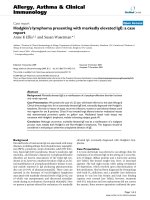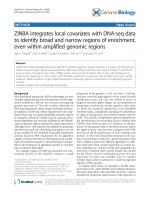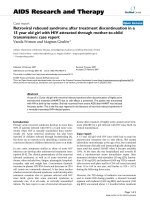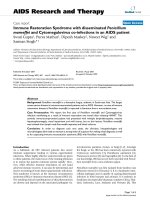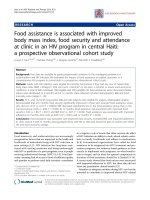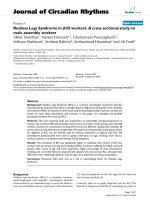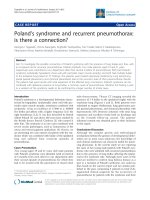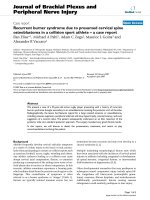Báo cáo y học: "Stiff person syndrome presenting with sudden onset of shortness of breath and difficulty moving the right arm: a case report" pps
Bạn đang xem bản rút gọn của tài liệu. Xem và tải ngay bản đầy đủ của tài liệu tại đây (1.82 MB, 5 trang )
JOURNAL OF MEDICAL
CASE REPORTS
Goodson et al. Journal of Medical Case Reports 2010, 4:118
/>Open Access
CASE REPORT
BioMed Central
© 2010 Goodson et al; licensee BioMed Central Ltd. This is an Open Access article distributed under the terms of the Creative Commons
Attribution License ( which permits unrestricted use, distribution, and reproduction in
any medium, provided the original work is properly cited.
Case report
Stiff person syndrome presenting with sudden
onset of shortness of breath and difficulty moving
the right arm: a case report
Bradley Goodson
1
, Kate Martin*
2
and Thomas Hunt
2
Abstract
Introduction: First described in 1956, stiff person syndrome is characterized by episodes of slowly progressive stiffness
and rigidity in both the paraspinal and limb muscles. Although considered a rare disorder, stiff person syndrome is
likely to be under-diagnosed due to a general lack of awareness of the disease in the medical community.
Case presentation: A 27-year-old Hispanic woman presented to our emergency department with a sudden onset of
shortness of breath and difficulty moving her right arm. Her physical examination was remarkable in that her abdomen
was firm to palpation and her right upper extremity was rigid on passive and active ranges of motion. Her right fingers
were clenched in a fist. Her electromyography findings were consistent with stiff person syndrome in the right clinical
setting. Stiff person syndrome is confirmed by testing for the anti-glutamic acid decarboxylase antibody. Her test for
this was positive.
Conclusion: Stiff person syndrome may not be a common condition. However, if disregarded in the differential
diagnosis, it can lead to several unnecessary tests being carried out causing a delay in treatment. This case report
reveals some of the characteristic features of stiff person syndrome with an atypical presentation.
Introduction
In 1956, Moersch and Woltman of the Mayo Clinic
described an unusual condition of muscle stiffening and
difficulty walking. They coined it "stiff man syndrome"
[1]. A more appropriate name "stiff person syndrome
(SPS)" was later suggested, as the condition affects both
sexes, possibly more women than men. Although consid-
ered a rare disorder, SPS is under-diagnosed due to a gen-
eral lack of awareness in the medical community.
Patients with SPS usually experience a prodrome of
stiffness and rigidity in the axial muscles of their cervical
or lumbar spine. There is a gradual worsening and pro-
gression of the condition over time which involves the
proximal limb muscles. Pain may be an associated symp-
tom, but significant stiffness and rigidity are the classical
features of the disorder. Some symptoms are reported to
cause spinal deformities, such as exaggerated lumbar lor-
dosis [2]. Ambulation can be dangerous because the nor-
mal postural reflexes of patients become replaced by
stiffness, thus placing them at greater risk of fractures.
Sometimes, the severity of proximal limb muscle stiffness
can overwhelm that of the axial muscles, leading to pre-
senting symptoms of arm or leg rigidity. Such a case is
described in this report.
Case presentation
A 27-year-old Hispanic woman presented to the Univer-
sity Medical Center Emergency Department in Las Vegas,
Nevada with a sudden onset of shortness of breath and
increased difficulty in moving her right arm. She
reported that during the evening prior to her presenta-
tion, she was lying down when she began to experience
shortness of breath with worsening right-arm weakness.
She also reported that for the past two months her arm
weakness was characterized as having limited strength
and range of motion. She also complained of chest pains
that were localized behind her sternum. The pain was
characterized as a pressure sensation that was non-radi-
ating. She did not have any aggravating or relieving fac-
tors. Pertinent positive findings included nausea,
* Correspondence:
2
Department of Family and Community Medicine, University of Nevada
School of Medicine, Fire Mesa Street, Las Vegas, Nevada 89128, USA
Full list of author information is available at the end of the article
Goodson et al. Journal of Medical Case Reports 2010, 4:118
/>Page 2 of 5
palpitations and lightheadedness. Pertinent negative
symptoms included no loss of consciousness, headache,
vomiting, diarrhea, or vertigo.
Our patient had been evaluated in the same emergency
department two months prior to this presentation for
right-arm weakness and dysphasia. During her prior
admission to the emergency department, she had
received multiple MRI studies of her brain and cervical
spine. A previous MRI of her brain had been unremark-
able but an MRI of her cervical spine had indicated some
mild cervical canal narrowing secondary to end-plate
changes and chronic kyphotic changes. At the time of her
previous admission, she was diagnosed with hemiplegic
migraine headache.
A systemic review of our patient was non-contributory
except for an associated dry cough. She denied having a
history of headaches or migraine headaches. Her vital
signs were stable, and she was afebrile, not tachycardic,
not tachypneic, and normotensive. She appeared anxious
during her physical examination. She also reported being
right-handed. Her cardiac and pulmonary examinations
were unremarkable. There were no murmurs on cardiac
auscultation noted during her examination, and there
were no wheezes, rales or rhonchi while auscultating her
lungs.
Her physical examination was remarkable in that her
abdomen was firm to palpation and her right upper
extremity was rigid on passive and active ranges of
motion. Her right fingers were clenched in a fist (Figure
1). When her fingers were passively extended the digits
spontaneously recoiled to the flexed and fist position
(Figure 2). Neurologically, she exhibited some dysarthria,
but her cranial nerves were intact.
She demonstrated five of the five muscle strength glob-
ally, despite exhibiting pain while we were assessing the
strength of her right hand. Her deep tendon reflexes were
1+ globally. While testing deep tendon reflexes we
noticed that her left leg was unshaven compared to her
right leg. She reported that because her hand was con-
stantly in a fist position she had been unable to shave her
left leg. The position sensations of both her great toes
were intact.
Our patient was placed under observation to rule out
acute coronary syndrome. Results of her initial routine
laboratory tests and chest X-ray were unremarkable.
Because she was complaining of shortness of breath, the
emergency room physicians ordered a computed tomog-
raphy angiogram (CTA) of her chest to rule out pulmo-
nary embolism, and the results came back negative. She
then underwent a cardiac stress test and a serial troponin
and cardiac enzyme test. Results of her stress test and
cardiac enzyme tests were negative. Because of her past
diagnosis of hemiplegic migraine headache and her per-
Figure 1 Image of our patient's right arm demonstrating fingers
in a fist-like position.
Figure 2 An image of our patient's right arm revealing spontane-
ous recoil of fingers to the flexed and fist positions following pas-
sive extension.
Goodson et al. Journal of Medical Case Reports 2010, 4:118
/>Page 3 of 5
sistent symptoms and dysarthria, a neurology consulta-
tion was requested. In addition, because her symptoms
did not have an obvious explanation, a psychiatric consult
was also ordered to rule out a factitious disorder, a con-
version disorder or malingering.
The consulting psychiatrist reported that her symp-
toms were not due to a factitious or conversion disorder.
It was also noted that she was not malingering, and her
symptoms were not due to an adjustment disorder. Her
level of anxiety was noted as appropriate.
Meanwhile, her consulting neurologist ordered an array
of laboratory and imaging studies because her clinical
presentation and history did not follow the pattern of
hemiplegic migraine. A vascular, rheumatological, coagu-
lopathy, or autoimmune disorder was further investi-
gated, as the etiology for her symptoms for these
possibilities could not be ruled out.
To rule out vascular etiology as a cause of her symp-
toms, she underwent a variety of imaging studies includ-
ing magnetic resonance angiogram (MRA) of her neck
with and without contrast, two separate MRIs of her
brain with and without contrast, an MRA of her head
without contrast, and a CTA of her head. The results of
the imaging studies found no cause for her spastic right
upper extremity. However, incidental findings included a
germ cell tumor in her pineal region, a narrowing of her
left internal carotid artery, and a 9 mm slightly enhancing
macroadenoma of the pituitary.
Meanwhile, the following tests were ordered to rule out
a coagulopathy: protein C deficiency, protein S defi-
ciency, factor V Leiden, factor II 20210, anti-cardiolipin
antibody studies, anti-thrombin III, factor II and fibrino-
gen levels, and all were all within the normal limits. In
addition, results of the following rheumatology labora-
tory tests were normal: sedimentation rate, C-reactive
protein, and rheumatoid factor levels. As for autoimmune
laboratory testing, her anti-double-stranded DNA was
above the normal limit with a value of 5. Her anti-nuclear
antibody (ANA) was positive, and the ANA titer was
1:320 and speckled.
With the above laboratory results and the clinical pre-
sentation of our patient, the possibility of an autoimmune
disorder was high. Our patient was informed of these
findings and their implications. She was started on a
medication of one gram Solu-Medrol (methylpredniso-
lone sodium succinate) infused over 24 hours for five
consecutive days. On the second day of her five-day treat-
ment, her consulting neurologist also ordered a lumbar
puncture and electromyography (EMG). However, the
lumbar puncture was unsuccessful because she was
unable to keep still during the procedure.
Meanwhile, EMG testing was performed in her right
upper extremity muscles, including the dorsal
interosseous, pronator teres, pectoral radialis, biceps, tri-
ceps, deltoid and opponens pollicis. In all the muscles
tested, frequent involuntary runs of motor units (contin-
uous motor unit activity) were identified. Through limb
repositioning, her resting activity was studied, revealing
absent fibrillations or positive waves. EMG testing of all
the muscles involved resulted in normal motor unit mor-
phology and normal recruitment. There was no evidence
of myokymic or neuromyotonic discharges. Her EMG
findings were consistent with SPS in the right clinical set-
ting. With this information, her Solu-Medrol (methyl-
prednisolone sodium succinate) treatment was
discontinued.
The confirmatory test for SPS, anti-glutamic acid
decarboxylase (GAD) antibody, was ordered. However,
because the test had to be sent to the Mayo Clinic in
Rochester, Minnesota, it took two weeks to receive the
results. While waiting for the results, our patient was
started on the accepted recommended therapy for SPS:
baclofen 10 mg orally three times per day for spasticity, as
well as intravenous immunoglobulin (IVIG) for five days
to increase her immune response. She was also started on
Klonopin (clonazepam) for her anxiety and 5/325 oxy-
codone/acetaminophen for pain.
Over the next five days she began to show clinical
improvement. Remarkable changes in her physical exam-
ination included a decrease in the spasticity of her right
arm, a renewed ability to extend the fingers of her right
hand, and an improvement in her dysarthria (Figures 3
and 4). Her abdominal muscles also became less firm. She
also received physical rehabilitation while in our hospital.
Because of the association between stiff person and para-
neoplastic syndromes, the appropriate laboratory investi-
gations for paraneoplastic syndrome were completed, for
which our patient's results were all negative.
Upon discharge she was referred to outpatient physical
therapy rehabilitation and a neurology follow-up
appointment. She also needed to take three medications
(baclofen, clonazepam and Percocet). Seven days after
her discharge we received the result of her anti-GAD
antibody examination, which was positive with a value of
3145 nmol/L (normal range is ≤ 0.02 nmol/L). It is impor-
tant to point out that the GAD antibody level is not useful
as a marker of disease severity or activity, or even as a
prognostic indicator. However, it is helpful from a diag-
nostic standpoint, as in our case. GAD antibody is highly
correlated with autoimmune conditions such as diabetes
and thyroid conditions. In our case, a thyroid-stimulating
hormone was in the normal range, fasting glucose was
less than 100 mg/dL, and our patient had no family his-
tory of autoimmune disorders. Hemoglobin A1C testing
was not performed on our patient, as her random blood
sugar levels were less than 200 mg/dL during the time of
her hospitalization.
Goodson et al. Journal of Medical Case Reports 2010, 4:118
/>Page 4 of 5
Discussion
Our case report illustrates an example of SPS with its
most prominent manifestation seen in the limb muscles.
A key feature of our patient's diagnosis was the occur-
rence of muscle spasms that were preceded by sudden
movement, loud noise or emotional stress, as described
in the literature [3]. Specific examples during our
patient's hospitalization that precipitated these episodes
included being awoken from sleep in the morning and
when the medical team entered her room for rounds, as
well as an intense fear that made her unable to tolerate a
lumbar puncture procedure. Autonomic dysfunction has
also been described in the literature. Our patient exhib-
ited some features of this when she had difficulty swal-
lowing, which may have been related to esophageal
dysmotility or laryngeal and pharyngeal spasms.
The manifestation of stiffness in an arm, as opposed to
the legs or the thoraco-lumbar spine, accompanied by
weakness is a peculiar presentation of SPS. However, we
feel that the multidisciplinary approach taken to arrive at
this diagnosis (neurology and psychiatry) helped us con-
sider many other possibilities.
A recent clinical follow-up on our patient revealed that
her symptoms are currently well controlled on a regimen
of oral diazepam 7.5 mg twice daily and oral baclofen 20
mg every six hours.
The GAD antibody is found in a number of neurologi-
cal conditions. One of the main inhibitory neurotrans-
mitters in the central nervous system, gamma-
aminobutyric acid (GABA), is regulated by GAD. A
decrease in function of the GAD enzyme can lead to less
available GABA and, subsequently, heightened stimula-
tion of muscles by motor neurons. The presence of GAD
antibodies explains part of this pathophysiological pro-
cess, because some patients with SPS are GAD antibody-
negative. However, GAD is not the only source of GABA.
There are other biochemical pathways involved in this
disorder that remain to be clarified.
The clinical associations of SPS with other disease pro-
cesses have been observed, including thyroid disorders,
insulin-dependent diabetes mellitus (IDDM) and epi-
Figure 3 Example of our patient's ability to actively extend fin-
gers of the right hand five days following the initiation of treat-
ment.
Figure 4 An image of our patient's right hand following passive
extension and without immediate recoil to the flexed position af-
ter five days of treatment.
Goodson et al. Journal of Medical Case Reports 2010, 4:118
/>Page 5 of 5
lepsy. Much understanding has come from a positive
association with GAD antibodies. According to one study
[4], IDDM is the most thoroughly documented condition,
observed in 25% of patients presenting with SPS. Others
cite the figure closer to 60% [5].
Electromyography can be helpful in the diagnosis of
SPS, with the detection of continuous motor unit activity,
especially in the paraspinal muscles. MRI or CT scanning
of the brain is only indicated if there are focal deficits
detected on neurological examination, such as abnormal
reflexes or frontal lobe signs. However, many patients
with SPS will have already undergone extensive imaging
as other more common or life-threatening diagnoses
were initially being investigated.
First described by Howard in 1963, diazepam is a well-
established therapy for SPS [6]. In this case, our patient
was initially prescribed the long-acting benzodiazepine
relative, clonazepam, and showed an improvement with
this medication while she was still in our hospital. Not
surprisingly, she also benefited from a muscle relaxant.
As in this case, IVIG can be used as an adjunctive therapy
in patients with SPS [7]. Although many patients with
SPS may not be able to tolerate physical therapy, it was
fundamental to our patient's recovery. While weakness is
not a typical symptom of SPS, some patients may feel
weak and have difficulty with newly regained voluntary
movements and fine motor skills.
Rituximab, a monoclonal antibody that binds to the
CD20 antigen on B-lymphocytes, has been associated
with the long-term remission of SPS, described in a case
report from the UK [8]. This report describes a 41-year-
old woman with SPS who did not respond to the tradi-
tional treatments described above. However, two weeks
following the administration of rituximab, her stiffness
improved dramatically. Her remaining symptoms were
well controlled with low dosages of benzodiazepines, fol-
lowed by a repeated course of rituximab several weeks
later. A phase II clinical trial conducted by the National
Institutes of Health investigating the use of rituximab in
patients with SPS was recently completed [9]. Although
no study results are available at this time, this information
may prove helpful to further assess the efficacy of this
immune modulator in the treatment of patients with SPS.
Conclusion
Stiff person syndrome is not a common condition, but it
should be considered in the differential diagnosis to avoid
unnecessary tests and a delay in treatment. Our case
report reveals some of the characteristic features of SPS.
However, because of its puzzling presentation, a multi-
disciplinary approach helped us reach a correct diagno-
sis.
Consent
Written informed consent was obtained from our patient
for publication of this case report and any accompanying
images. A copy of the written consent is available for
review by the Editor-in-Chief of this journal.
Abbreviations
ANA: anti-nuclear antibody; CT: computed tomography; DNA: deoxyribonu-
cleic acid; EMG: electromyography; GABA: gamma-aminobutyric acid; GAD:
glutamic acid decarboxylase; IDDM: insulin-dependent diabetes mellitus; IVIG:
intravenous immunoglobulin; MRA: magnetic resonance angiogram; MRI:
magnetic resonance imaging; nmol/L: nanomole per liter; SPS: stiff person syn-
drome.
Competing interests
The authors declare that they have no competing interests.
Authors' contributions
TH was the attending physician. KM was a second-year family medicine resi-
dent physician and BG was a first-year psychiatry resident physician. BG per-
formed an extensive literature search. Both KM and BG wrote the manuscript.
TH reviewed and edited the manuscript. All authors read and approved the
final manuscript.
Author Details
1
Department of Psychiatry, University of Nevada School of Medicine, West
Charleston Boulevard, Las Vegas, Nevada 89102, USA and
2
Department of
Family and Community Medicine, University of Nevada School of Medicine,
Fire Mesa Street, Las Vegas, Nevada 89128, USA
References
1. Moersch FP, Woltman HW: Progressive fluctuating muscular rigidity and
spasm ("stiff-man" syndrome): report of a case and some observations
in 13 other cases. Mayo Clin Proc 1956, 31:421-427.
2. Lorish TR, Thorsteinsson G, Howard FM Jr: Stiff-man syndrome updated.
Mayo Clin Proc 1989, 14:629-636.
3. Kimura J: Electrodiagnosis in Diseases of Nerve and Muscle: Principles
and Practice. 2nd edition. Philadelphia: FA Davis; 1989.
4. Solimena M, Folli F, Aparisi R, Pozza G, DeCamilli P: Autoantibodies to
GABAergic neurons and pancreatic beta cells in stiff-man syndrome. N
Engl J Med 1990, 322:1555-1560.
5. Dalakas MC, Fujii M, Li M, McElroy B: The clinical spectrum of anti-GAD
antibody-positive patients with stiff-person syndrome. Neurology 2000,
55:1531-1535.
6. Howard FM Jr: A new and effective drug in the treatment of stiff-man
syndrome. Mayo Clin Proc 1963, 38:203-212.
7. Dalakas MC: Intravenous immunoglobulin in patients with anti-GAD
antibody-associated neurological diseases and patients with
inflammatory myopathies: effects on clinicopathological features and
immunoregulatory genes. Clin Rev Allergy Immunol 2005, 29(3):255-269.
8. Baker MR, Das M, Fawcett PRW, Bates D: Treatment of stiff person
syndrome with rituximab. J Neurol Neurosurg Psychiatry 2005,
76:999-1001.
9. National Institutes of Health: Rituximab to Treat Stiff Person Syndrome.
Bethesda, MD; ClinicalTrials.gov Identifier: NCT00091897 [http://
clinicaltrials.gov/ct2/show/NCT00091897].
doi: 10.1186/1752-1947-4-118
Cite this article as: Goodson et al., Stiff person syndrome presenting with
sudden onset of shortness of breath and difficulty moving the right arm: a
case report Journal of Medical Case Reports 2010, 4:118
Received: 21 October 2009 Accepted: 27 April 2010
Published: 27 April 2010
This article is available from: 2010 Goodson et al; licensee BioMed Central Ltd. This is an Open Access article distributed under the terms of the Creative Commons Attribution License ( which permits unrestricted use, distribution, and reproduction in any medium, provided the original work is properly cited.Journal of Medical Case Repo rts 2010, 4:118

